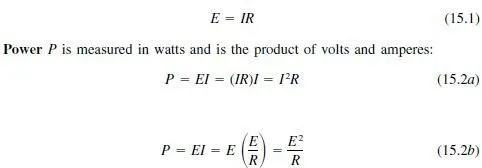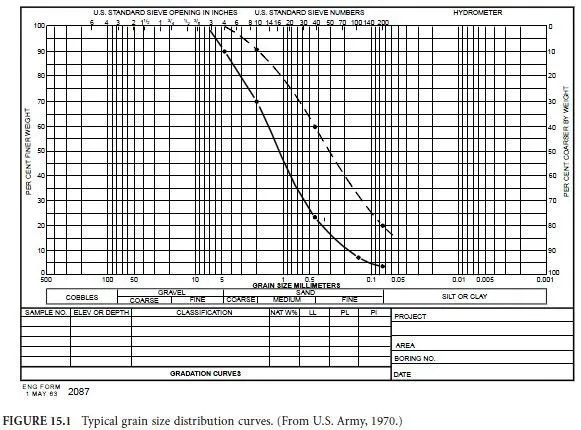Large-grained materials such as cobbles and boulders are sometimes considered to be soil. The differentiation of cobbles and boulders depends somewhat on local practice, but boulders are generally taken to be particles larger than 200 to 300 mm or 9 to 12 in. The Unified Soil Classification System suggests that boulders be defined as particles that will not pass a 12-in. (300 mm) opening. Cobbles are smaller than boulders and range down to particles that are retained on a 3-inch (75 mm) sieve. Gravels and sands are classified as coarse-grained soils; silts and clays are fine-grained soils. For engineering purposes, gravel is defined as soil that passes a 3-inch (75 mm) sieve and is retained by a No. 4 sieve (4.75 mm or 0.187 in.) or No. 10 sieve (2.00 mm or 0.078 in.), depending on the classification system. Sand is defined as soil particles smaller than gravel but retained on a No. 200 sieve (0.075 mm or about 0.003 in.). Soils passing the No. 200 sieve may be silt or clay. Although grain-size criteria were used in some older classification systems to differentiate silt from clay, the two systems described herein make this differentiation based on plasticity rather than grain size.
 The grain-size characteristics of soils that are predominantly coarse grained are evaluated by a sieve analysis. A nest of sieves is prepared by stacking sieves one above the other with the largest opening at the top followed by sieves of successively smaller openings and a catch pan at the bottom. Opening sizes of commonly used sieves are shown in Table 15.1. A sample of dry soil is poured onto the top sieve, the nest is covered, and it is then shaken by hand or mechanical shaker until each particle has dropped to a sieve with openings too small to pass, and the particle is retained. The cumulative weight of all material larger than each sieve size is determined and divided by the total sample weight to obtain the percent retained for that sieve size, and this value is subtracted from 100% to obtain the percent passing that sieve size. Results are displayed by plotting the percent passing (on a linear scale) against the sieve opening size (on a log scale) and connecting the plotted points with a smooth curve referred to as a grain-size distribution curve. A sample of some grain-size distribution curves is presented in Fig. 15.1. The notation D xx refers to the size D , in mm, for which xx percent of the sample by weight passes a sieve with an opening equal to D . The D 10 si ze, sometimes called the effective grain size, is the grain diameter for which 10% of the sample (by weight) is finer. It is determined from the grain-size distribution curve at the point where the curve crosses a h orizontal line through the 10% passing value on the y axis. Other D sizes are found in a similar manner. The D 50 size, called the median grain size, is the grain diameter for which half the sample (by weight) is smaller and half is larger. Two parameters are used to describe the general shape of the grain-size distribution curve. The coefficient of uniformity, C u , is:
The grain-size characteristics of soils that are predominantly coarse grained are evaluated by a sieve analysis. A nest of sieves is prepared by stacking sieves one above the other with the largest opening at the top followed by sieves of successively smaller openings and a catch pan at the bottom. Opening sizes of commonly used sieves are shown in Table 15.1. A sample of dry soil is poured onto the top sieve, the nest is covered, and it is then shaken by hand or mechanical shaker until each particle has dropped to a sieve with openings too small to pass, and the particle is retained. The cumulative weight of all material larger than each sieve size is determined and divided by the total sample weight to obtain the percent retained for that sieve size, and this value is subtracted from 100% to obtain the percent passing that sieve size. Results are displayed by plotting the percent passing (on a linear scale) against the sieve opening size (on a log scale) and connecting the plotted points with a smooth curve referred to as a grain-size distribution curve. A sample of some grain-size distribution curves is presented in Fig. 15.1. The notation D xx refers to the size D , in mm, for which xx percent of the sample by weight passes a sieve with an opening equal to D . The D 10 si ze, sometimes called the effective grain size, is the grain diameter for which 10% of the sample (by weight) is finer. It is determined from the grain-size distribution curve at the point where the curve crosses a h orizontal line through the 10% passing value on the y axis. Other D sizes are found in a similar manner. The D 50 size, called the median grain size, is the grain diameter for which half the sample (by weight) is smaller and half is larger. Two parameters are used to describe the general shape of the grain-size distribution curve. The coefficient of uniformity, C u , is:

